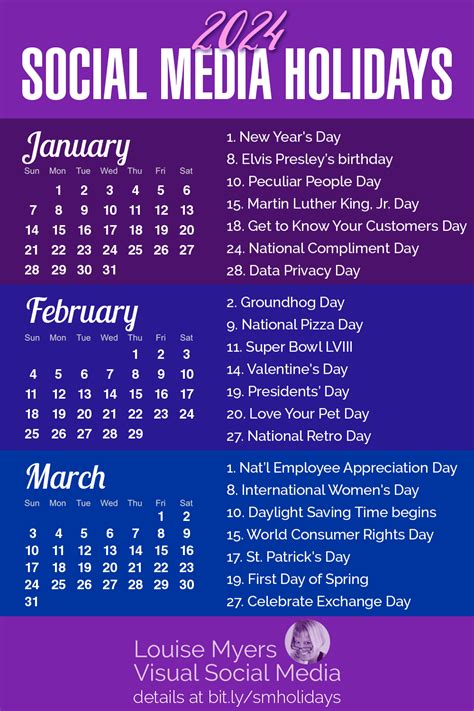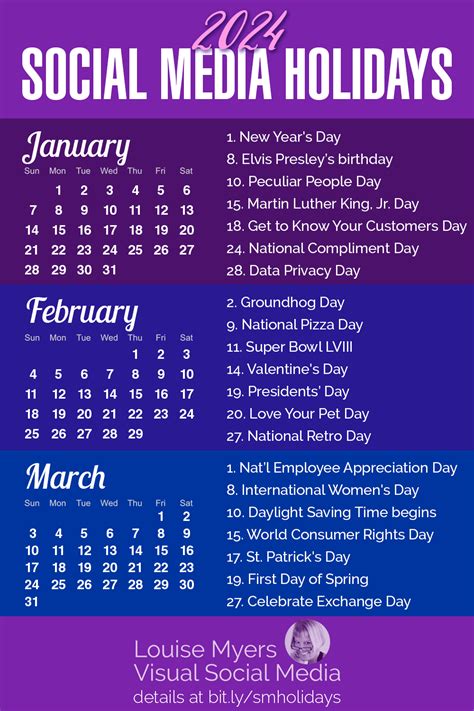Discover the top 10 holidays to include in your 2024 social media calendar. Learn how to create engaging content, measure success, and adjust your strategy.Are you ready to level up your social media game in 2024? With the right holiday content on your calendar, you can engage your audience, drive traffic, and boost your brand. In this blog post, we’ll explore the top 10 holidays to include in your 2024 social media calendar. From researching holiday trends for the upcoming year to creating engaging content and measuring its success, we’ll cover everything you need to know to make the most of these key dates. Whether it’s Christmas, Halloween, or International Coffee Day, we’ll show you how to select holidays relevant to your audience and schedule posts in advance for maximum impact. By adjusting your strategy for upcoming holidays, you can stay ahead of the game and ensure your social media calendar is primed for success. Let’s dive in and get ready to create a winning holiday content strategy for 2024.
Researching holiday trends for 2024
When it comes to planning your social media calendar for the upcoming year, it’s crucial to stay ahead of the game by researching holiday trends for 2024. By staying informed of the latest holiday trends, you can ensure that your content remains relevant and engaging for your audience. One way to stay on top of holiday trends is to monitor popular social media platforms for trending topics and hashtags related to upcoming holidays. This can give you valuable insight into the types of content that are resonating with users and help you tailor your holiday content accordingly.
Another valuable resource for researching holiday trends is industry reports and research studies that provide insights into consumer behavior and preferences for upcoming holidays. These reports can give you a better understanding of the types of holidays that are gaining traction with consumers and the types of content that are likely to perform well on social media. By leveraging these insights, you can ensure that your holiday content aligns with current consumer preferences and is more likely to resonate with your target audience.
Additionally, it’s important to keep an eye on popular culture and current events that may influence holiday trends for 2024. By staying informed about the latest developments in popular culture, entertainment, and other relevant industries, you can gain valuable insights into the holidays that are likely to capture the attention of your audience. This can help you create more timely and engaging holiday content that is relevant to current trends and interests.
Selecting holidays relevant to your audience
When planning your social media calendar for 2024, it’s important to consider the holidays that will resonate with your specific audience. Selecting holidays that are relevant to your target demographic will result in higher engagement and a stronger connection with your followers. Take the time to research the demographics of your audience and identify the holidays that hold significance to them.
Consider the cultural and religious backgrounds of your audience and include holidays that align with their beliefs and traditions. For example, if your audience is predominantly Christian, including Christmas and Easter in your social media calendar would be a great way to engage with them on a personal level. Additionally, consider any regional or national holidays that are important to your audience, as these will also help in creating a sense of community and connection.
Utilize your social media analytics to gain insights into the interests and behaviors of your audience. Look at past holiday posts and analyze which ones received the most engagement. This will give you valuable data on which holidays are most relevant to your audience and which ones you should prioritize in your social media calendar for 2024.
| Holiday | Relevance to Audience |
|---|---|
| Christmas | High engagement, majority of audience celebrates |
| Diwali | Significant portion of audience celebrates, opportunity to reach new followers |
| Chinese New Year | Growing interest among audience, potential for cross-cultural connection |
| Independence Day | National celebration, sense of community and patriotism |
By selecting holidays that are relevant to your audience, you can create content that resonates with them on a deeper level and strengthens your brand’s relationship with your followers. This targeted approach will result in more meaningful interactions and a stronger sense of community within your social media platform.
Creating engaging content for each holiday
When creating engaging content for each holiday, it’s important to consider the unique characteristics and customs associated with each holiday. By researching the traditions, history, and significance of the holiday, you can tailor your content to resonate with your audience. Whether it’s creating festive graphics, sharing holiday-themed recipes, or highlighting the impact of the holiday on your industry, there are countless ways to creatively engage your audience.
Additionally, it’s essential to consider the diversity of your audience when creating holiday content. Be mindful of the various holidays celebrated around the world and incorporate a range of cultural perspectives into your content. This not only shows your inclusivity and respect for diverse traditions, but also allows you to connect with a wider audience.
One effective way to engage your audience is by involving them in the content creation process. Encourage your followers to share their own holiday experiences, traditions, and memories, and feature user-generated content on your social media platforms. This not only fosters a sense of community, but also provides valuable insights into the preferences and interests of your audience.
Scheduling posts in advance for holidays
Top 10 Holidays to Include in Your 2024 Social Media Calendar
When it comes to social media marketing, planning ahead is crucial. This is especially true when it comes to holiday posts. By scheduling your holiday posts in advance, you can ensure that you are prepared for upcoming holidays and that you don’t miss out on any key opportunities to engage with your audience.
One way to stay organized and ahead of the game is to create a social media calendar that includes all of the major holidays relevant to your audience. By planning out your posts well in advance, you can ensure that you have a consistent and timely presence on social media during these important times of year.
Another benefit of scheduling posts in advance is that it allows you to dedicate more time to creating high-quality and engaging content for each holiday. Instead of scrambling at the last minute to come up with ideas, you can take the time to brainstorm and develop creative posts that will resonate with your audience.
| Holiday | Important Date |
|---|---|
| New Year’s Day | January 1st |
| Valentine’s Day | February 14th |
| St. Patrick’s Day | March 17th |
| Independence Day | July 4th |
By taking the time to schedule your holiday posts in advance, you can ensure that your social media marketing strategy is well-prepared, organized, and effective. This will ultimately lead to better engagement, increased brand awareness, and a stronger connection with your audience.
Measuring the success of holiday posts
When it comes to social media marketing, it’s crucial to have a clear understanding of how to measure the success of your holiday posts. Simply posting content and hoping for the best won’t give you the insights you need to improve your strategy. You need to use analytical tools to track the performance of your holiday posts and determine their effectiveness.
One way to measure the success of your holiday posts is by looking at engagement metrics such as likes, comments, shares, and clicks. These metrics can give you an idea of how well your holiday content resonates with your audience. By analyzing the engagement data, you can identify which holidays generated the most interest and adjust your content strategy accordingly.
Another important aspect of measuring the success of holiday posts is conversion tracking. This involves tracking the number of conversions that resulted from your holiday posts, whether it’s website visits, newsletter sign-ups, or sales. By tracking conversions, you can determine the ROI of your holiday content and see which holidays were most effective in driving action from your audience.
Furthermore, it’s essential to analyze the reach and impressions of your holiday posts. This will give you insight into how many people saw your holiday content and how many times it was displayed on their feeds. By understanding the reach and impressions of your holiday posts, you can evaluate the overall visibility and impact of your holiday content.
Adjusting strategy for upcoming holidays
As social media marketers, it’s important to continuously adjust our strategies based on upcoming holidays. Whether it’s a national holiday, cultural celebration, or trending event, incorporating these into our social media calendar can significantly impact our engagement and reach. This process involves staying updated on holiday trends, understanding your audience’s interests and preferences, and being flexible with our content planning.
When adjusting our strategy for upcoming holidays, it’s crucial to conduct thorough research to identify which holidays are relevant to our target audience. This may involve analyzing past holiday-themed posts to determine which holidays generated the most engagement and conversions. By utilizing analytics tools, we can gain valuable insights into our audience’s behavior and preferences and tailor our strategy accordingly.
Another important aspect of adjusting our strategy for upcoming holidays is scheduling posts in advance. By planning and creating content ahead of time, we can ensure that our social media calendar aligns with upcoming holidays and events. This allows us to maintain an active and engaging presence on social media, as well as allocate sufficient time for content creation and campaign planning around these holidays.
Measuring the success of our holiday posts is also key to adjusting our strategy for upcoming holidays. By analyzing
, we can evaluate the impact of our holiday-themed content and make data-driven decisions for future campaigns. By tracking KPIs related to holiday posts, we can identify which holidays resonate with our audience and adjust our content strategy accordingly.
Frequently Asked Questions
What are some popular holidays to include in a social media calendar?
Some popular holidays to include are Christmas, New Year’s Day, Valentine’s Day, Halloween, and Thanksgiving.
How can holidays be incorporated into a social media calendar?
Holidays can be incorporated by creating themed content, running holiday-themed promotions or contests, and sharing holiday-related tips or facts.
Why is it important to include holidays in a social media calendar?
Including holidays in a social media calendar helps to keep content relevant and engaging, and it allows businesses to connect with their audience on a personal and emotional level.
Should businesses tailor their content for different holidays?
Yes, businesses should tailor their content for different holidays to resonate with their audience and show that they are aware and respectful of diverse cultures and traditions.
What are some lesser-known holidays that can be included in a social media calendar?
Some lesser-known holidays to include are International Women’s Day, Earth Day, National Pet Day, and World Kindness Day.
How far in advance should businesses plan their social media content for holidays?
It’s recommended to plan social media content for holidays at least one to two months in advance to allow time for brainstorming, creating visuals, and scheduling posts.
How can businesses measure the success of their holiday-themed social media content?
Businesses can measure the success of their holiday-themed content by tracking metrics such as engagement rates, click-through rates, and overall reach. Analyzing feedback and comments can also provide valuable insights.


